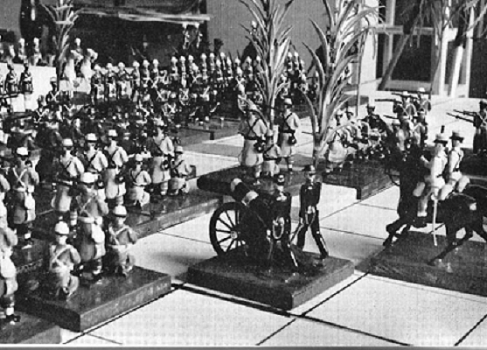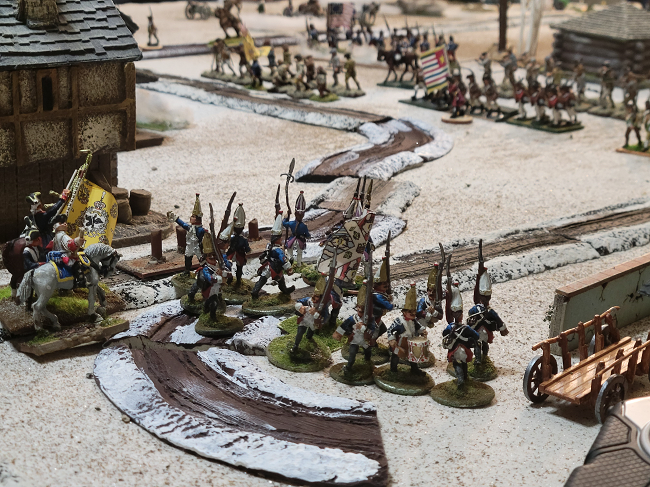

The history of wargaming can be traced back to ancient times, where various forms of strategy games were played to simulate military conflicts. Below is a very brief history of wargaming.
Strategy games with military themes have been played since ancient times. Examples include the ancient Indian game of Chaturanga (the precursor to Chess), the Chinese game of Go, and the Roman game of Ludus Latrunculorum. These early games involved strategic movement and decision-making.
In 1780, Johann Christian Ludwig Hellwig invented the first proper war game, called Kriegsspiel. Kriegsspiel was a tabletop game that used wooden blocks to represent troops and terrain. Players would move their blocks around the board according to a set of rules, and the outcome of the game would be determined by the results of simulated battles. This game was played by military strategists.
In the early 19th century, the Prussian army developed a wargame called by the same name: Kriegsspiel. It was designed to train military officers in strategic and tactical decision-making. Kriegsspiel used scale models and terrain boards to simulate battlefield situations. It was used to test new military theories and in planning of future campaigns, This marked a significant milestone in the formalization and use of wargames for military training purposes.
The success of Kriegsspiel led to the development of other wargames in other countries. In the United States, Charles A.L. Totten invented a wargame called Strategos in 1880. Strategos was similar to Kriegsspiel, but it used more complex rules and allowed for larger battles.
Robert Louis Stevenson, author of Treasure Island started his wargaming adventures in 1881.
Little Wars: In 1913, author H.G. Wells published a book called “Little Wars,” which introduced a set of rules for a toy soldier wargame. Wells’ rules emphasized simplicity and provided a framework for recreational wargaming with miniatures. “Little Wars” is considered one of the earliest examples of a tabletop wargame for entertainment purposes.
In the early 20th century, wargaming became increasingly popular as a hobby. Commercial wargame publishers began to produce a wide variety of games, covering a broad range of historical periods and conflicts. Wargaming clubs and associations were also formed, providing players with a place to meet and play games.
In the 1950s and 1960s, the American company Avalon Hill became a prominent publisher of wargames. They produced a wide range of board games focused on historical conflicts, offering detailed rules, maps, and counters to simulate battles. Avalon Hill’s games, such as “Tactics II” and “Diplomacy,” helped popularize wargaming as a hobby.
The popularity of war gaming declined somewhat after World War II, but it experienced a resurgence in the 1970s and 1980s. This was due in part to the development of new wargame rules and systems, as well as the introduction of wargames to a wider audience through books, magazines, and video games.
In the 1970s, the development of tabletop miniature wargames gained momentum. Games like “Warhammer Fantasy Battle” and “Warhammer 40,000” by Games Workshop introduced highly detailed miniatures and elaborate game systems. These games allowed players to build and customize armies, engage in strategic battles, and immerse themselves in rich fantasy or science fiction settings.
With the advent of computers, wargaming expanded into the digital realm. In the 1980s and 1990s, computer wargames gained popularity, offering players the ability to simulate complex military conflicts with sophisticated graphics and artificial intelligence. Titles like “Civilization,” “Panzer General,” and “Total War” series brought wargaming to a wider audience.
Wargaming continues to evolve and thrive in both tabletop and digital formats. Tabletop wargames encompass a wide range of genres, historical periods, and complexity levels. Meanwhile, digital wargames continue to push boundaries with advanced graphics, online multiplayer capabilities, and realistic simulations. Today, wargaming is a thriving hobby with a global community of players. There are hundreds of different wargame publishers and thousands of different wargames available. Wargaming clubs and associations can be found in most major cities throughout the globe.
It combines strategy, history, craftsmanship, and storytelling, allowing players to immerse themselves in simulated battles and recreate historical conflicts or engage in fictional wars.


